
Achieving goals means doing the work that brings success. This includes getting yourself organised on a daily basis by planning your time. When you consciously and intentionally choose how and where you spend your time, you minimise stress that otherwise builds up when you have to rush to get things done at the last minute. To help you plan your time for a highly successful day, I’ve created a beautiful daily planner that you can download and print from my website. And it’s free! Read on for some tips on how to use the planner to make the best investment of your time each day.
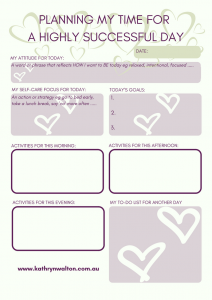
Plan Your Time for a Highly Successful Day
Your planner has been designed to be quick and easy to use. When you invest a couple of minutes each day into planning how you choose to spend your time, the payoffs can be enormous! A little bit of organisation goes a long way. Here are a few tips to get you started with your planner.
Choose an attitude to take you through the day
It’s all well and good that you make an action plan, but it’s even more important to choose an attitude for the day. Visualise yourself selecting and clothing yourself in an attitude each morning, just as you choose which clothes to wear. Writing your attitude down on your planner, right at the very top, will keep it present in all that you do. Here are some examples of attitudes that you might like to choose from (but really, the sky is the limit with choice here!)
- relaxed

- focused
- intentional
- mindful
- gentle
- assertive / firm
- warrior
- action-oriented
- efficient
- patient
Choose a self-care focus for the day
Self-care makes you more resilient and gives you strength. But it can easily get tossed to the side when you’re busy. Don’t be a self-sacrificing martyr – the world needs you to stay strong – so make sure your self-care stays high on your list of priorities. Some examples of self-care that you can incorporate into your day include:
- go to bed at …….. (write down the time you intend to go to bed)
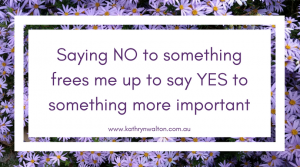
- take my lunch break away from my work
- say ‘no’ more often
- go for a walk
- chat with a friend
- take the time to cook a nutritious meal
- meditate
- read a book for ½ hour
Choose 2 – 3 goals for the day
Don’t be overwhelmed by your to-do list. Be realistic. Choose just 2 or 3 tasks to prioritise for each day. When you achieve your short list of objectives, you’ll feel a sense of accomplishment and motivation. And that’s much better than feeling overwhelmed at the enormity of everything on your ever-expanding to-do list that you haven’t accomplished in the day. Some days my short list of goals or priorities looks like this:
2. be on time for school pick-up
3. have dinner ready by 7pm
Other days I choose goals that require more energy and focus, such as:
1. write and publish a blog post
2. update clinical records
3. research and write new privacy policy
Break the day up into sections
I often refer to this technique as “chunking it down”. When you break the day up into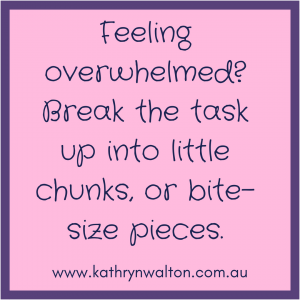 chunks, you’re better able to focus on that one period of time. You work more efficiently and effectively, gain a sense of achievement throughout the day, and feel less overwhelmed by the enormity of what’s on your plate. This type of scheduling can be applied to many different situations including school assignments, boring tasks, housework, meetings and so on. On your planner you can break up the activities you want (or need) to focus on in the morning, afternoon and evening. Here’s an example of what my planner sometimes looks like:
chunks, you’re better able to focus on that one period of time. You work more efficiently and effectively, gain a sense of achievement throughout the day, and feel less overwhelmed by the enormity of what’s on your plate. This type of scheduling can be applied to many different situations including school assignments, boring tasks, housework, meetings and so on. On your planner you can break up the activities you want (or need) to focus on in the morning, afternoon and evening. Here’s an example of what my planner sometimes looks like:
Activities for This Morning
- go for walk
- pay the bills online
- clinical and administration tasks
Activities for This Afternoon
- watch a training video
- get the groceries while my son is at his speech lesson
Activities for This Evening
- reheat leftovers for dinner
- join my online video mentoring group
Keep a list of to-do’s to carry over to another day
At the bottom of your planner there is space for you to keep a list of tasks, activities and other to-do’s that weren’t on your priority list for today. Having them handy here means that if your day has gone smoothly and you have time and energy up your sleeve, you can easily run your eye down this list and select additional tasks to work on. Or, perhaps things haven’t worked out today as expected and you need to reorganise your priorities. This space also enables you to make a record of tasks as you think of them so they don’t get lost in your hazy busy brain! My ‘to-do list for another day’ is quite extensive. I use it like a bank of tasks that I can select my priority goals from each day, and then cross them out as I achieve them!
other to-do’s that weren’t on your priority list for today. Having them handy here means that if your day has gone smoothly and you have time and energy up your sleeve, you can easily run your eye down this list and select additional tasks to work on. Or, perhaps things haven’t worked out today as expected and you need to reorganise your priorities. This space also enables you to make a record of tasks as you think of them so they don’t get lost in your hazy busy brain! My ‘to-do list for another day’ is quite extensive. I use it like a bank of tasks that I can select my priority goals from each day, and then cross them out as I achieve them!
So there you have it! A system to plan your time for a highly successful day. And a reminder to be gentle with yourself when it doesn’t all go to plan. This system is simply a plan – a flexible tool to guide your daily choices and actions. Experiment with the plan to see what works best for you.
Take a Minute for Your Mind
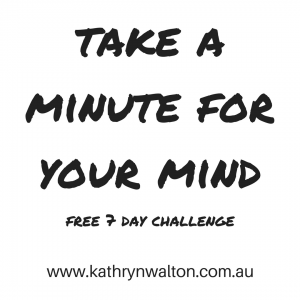 HAVE YOU SIGNED UP FOR MY FREE 7 DAY CHALLENGE “TAKE A MINUTE FOR YOUR MIND”? Available for a limited time only! For more information and to register, go to the OFFERS tab on my website!
HAVE YOU SIGNED UP FOR MY FREE 7 DAY CHALLENGE “TAKE A MINUTE FOR YOUR MIND”? Available for a limited time only! For more information and to register, go to the OFFERS tab on my website!
Discovering mountain biking as life’s ultimate parallel universe in her middle age,  Kathryn Walton shares information and reflections in Daisy Spoke that connect, inspire and self-empower women to make healthy choices for themselves. She integrates her love of physical exercise, family, nature, gardening and creative arts with her professional background in mental health social work to facilitate change with individuals, groups and communities of women who are committed to living life to the full.
Kathryn Walton shares information and reflections in Daisy Spoke that connect, inspire and self-empower women to make healthy choices for themselves. She integrates her love of physical exercise, family, nature, gardening and creative arts with her professional background in mental health social work to facilitate change with individuals, groups and communities of women who are committed to living life to the full.
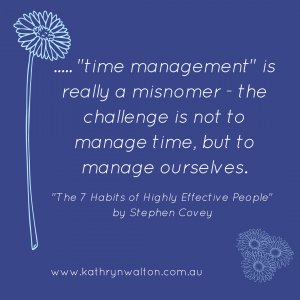


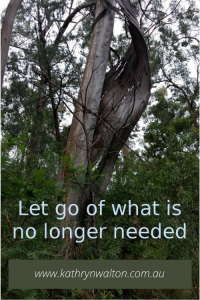

 So first of all, make sure you GET THE BIG ROCKS IN YOUR LIFE FIRST. They are your priorities so take steps to make sure you allow plenty of time and energy for them. Next put in your medium-sized rocks. Your small rocks go in after that and will be able to settle into the spaces between the bigger rocks. You can be more flexible with how they fit into your life. Next comes the sand. These things will be able to flow into the spaces that you have left. If there isn’t time and energy for them right now, that doesn’t matter. When things settle, they’ll have a place in your bucket once again.
So first of all, make sure you GET THE BIG ROCKS IN YOUR LIFE FIRST. They are your priorities so take steps to make sure you allow plenty of time and energy for them. Next put in your medium-sized rocks. Your small rocks go in after that and will be able to settle into the spaces between the bigger rocks. You can be more flexible with how they fit into your life. Next comes the sand. These things will be able to flow into the spaces that you have left. If there isn’t time and energy for them right now, that doesn’t matter. When things settle, they’ll have a place in your bucket once again. 
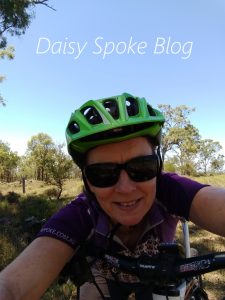 Daily exercise and general physical activity are crucial elements of feeling good. Just as some people might need to diligently take medication every day, I need to exercise every day. Exercise is nature’s way of stimulating the hormones which aid concentration, problem-solving, sleep, digestion, and mood. This daily dose of exercise rebalances our body’s systems resulting in wide-ranging benefits that no single medication can provide. The research is absolutely clear that regular medium to high intensity exercise can have a profound effect on health AND happiness.
Daily exercise and general physical activity are crucial elements of feeling good. Just as some people might need to diligently take medication every day, I need to exercise every day. Exercise is nature’s way of stimulating the hormones which aid concentration, problem-solving, sleep, digestion, and mood. This daily dose of exercise rebalances our body’s systems resulting in wide-ranging benefits that no single medication can provide. The research is absolutely clear that regular medium to high intensity exercise can have a profound effect on health AND happiness.
 Minds are such complex things! They wield a lot of power over our emotions and our actions (including sleep). But unless you notice what’s going on in your mind, and choose how much power to give it, your thoughts, assumptions and beliefs will control you instead of the other way around. The habit of being hooked by thoughts or strongly attached to them is limiting and anxiety-provoking. The key here is to begin by simply noticing what is happening in your mind, and by doing this with curiosity and without judgement. The power is in the noticing. You’ll collect all sorts of interesting bits of information about how your mind works, what thinking patterns it gets locked into, what beliefs and assumptions are behind it all, and how all of this impacts your physiology, your behaviours and your emotions. One of my favourite sayings is “Don’t believe everything you think!” because we can learn to stand back, notice the thought and choose whether to believe it, or not.
Minds are such complex things! They wield a lot of power over our emotions and our actions (including sleep). But unless you notice what’s going on in your mind, and choose how much power to give it, your thoughts, assumptions and beliefs will control you instead of the other way around. The habit of being hooked by thoughts or strongly attached to them is limiting and anxiety-provoking. The key here is to begin by simply noticing what is happening in your mind, and by doing this with curiosity and without judgement. The power is in the noticing. You’ll collect all sorts of interesting bits of information about how your mind works, what thinking patterns it gets locked into, what beliefs and assumptions are behind it all, and how all of this impacts your physiology, your behaviours and your emotions. One of my favourite sayings is “Don’t believe everything you think!” because we can learn to stand back, notice the thought and choose whether to believe it, or not. Click here to read my last blog post
Click here to read my last blog post 
 example of mine was
example of mine was 
 You can collect them from songs, poems, books and social media in addition to listening to your own inner wisdom. Write them on sticky notes, in a journal or diary, print out visual reminders to stick around your home or workplace, or even use them as screen savers and wallpapers on your electronic devices. Some examples include “Just do it”, “One drop raises the ocean”, “Keep it simple”, “Just breathe”, “Stand tall”.
You can collect them from songs, poems, books and social media in addition to listening to your own inner wisdom. Write them on sticky notes, in a journal or diary, print out visual reminders to stick around your home or workplace, or even use them as screen savers and wallpapers on your electronic devices. Some examples include “Just do it”, “One drop raises the ocean”, “Keep it simple”, “Just breathe”, “Stand tall”.
 lying on the beach, your stresses trickling away into the sand beneath you) or to help you progress towards a goal (eg visualise yourself speaking in front of an audience, feeling confident, upright posture, smiling, relaxed). When I’m feeling nervous about riding my bike on a particular section of track, I stop for a few moments and picture myself riding it the way I want it to go, as if I’m watching a short video of myself successfully negotiating that section. It truly is a powerful mind-based strategy and one you can use in every area of your life.
lying on the beach, your stresses trickling away into the sand beneath you) or to help you progress towards a goal (eg visualise yourself speaking in front of an audience, feeling confident, upright posture, smiling, relaxed). When I’m feeling nervous about riding my bike on a particular section of track, I stop for a few moments and picture myself riding it the way I want it to go, as if I’m watching a short video of myself successfully negotiating that section. It truly is a powerful mind-based strategy and one you can use in every area of your life.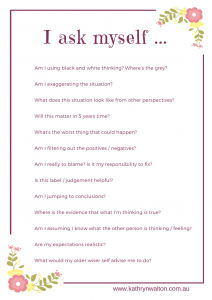 the mix. And to help you keep your strategies in play, I’ve created a free printable for you. “I ask myself …” is a beautiful keepsake of the helpful questions listed above. You can
the mix. And to help you keep your strategies in play, I’ve created a free printable for you. “I ask myself …” is a beautiful keepsake of the helpful questions listed above. You can 

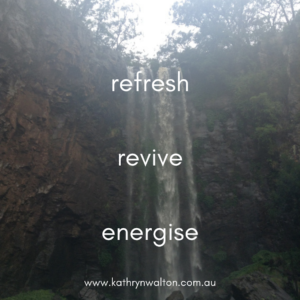
 Kathryn Walton shares information and reflections in Daisy Spoke that connect, inspire and self-empower women to make healthy choices for themselves.
Kathryn Walton shares information and reflections in Daisy Spoke that connect, inspire and self-empower women to make healthy choices for themselves.
 There’s a recognised association between wellness and outdoor activity. Simply being surrounded by nature is a step towards feeling more relaxed. With the sunshine stimulating our brains and enhancing our mood, there’s no better all-natural way to manage stress. Even just a few minutes outdoors is beneficial, so if you don’t have enough time for a long ride ….. have a short ride! With a bit of fresh air and sunshine, you’ll blow away the cobwebs in your mind and reconnect with those things that bring you joy.
There’s a recognised association between wellness and outdoor activity. Simply being surrounded by nature is a step towards feeling more relaxed. With the sunshine stimulating our brains and enhancing our mood, there’s no better all-natural way to manage stress. Even just a few minutes outdoors is beneficial, so if you don’t have enough time for a long ride ….. have a short ride! With a bit of fresh air and sunshine, you’ll blow away the cobwebs in your mind and reconnect with those things that bring you joy.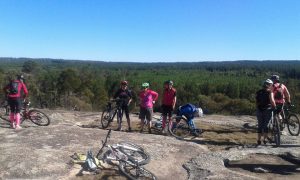 Sedentary behaviour is considered a modern danger to our health with risks so serious that the problem has been compared to that of smoking. Physical activity refers to general movement throughout the day, so it has a broader meaning than ‘exercise’. Bike riding is a low impact activity and therefore a great choice for people of all ages and abilities. MTB in particular gets your whole body moving as you navigate rougher terrain. You can jump on your mountain bike to commute to and from work on paved surfaces, or hit the trails that are purpose built for recreational use. Cross country, downhill, enduro, freestyle, trials, or whatever is your preference ….. the main idea is to get your body moving.
Sedentary behaviour is considered a modern danger to our health with risks so serious that the problem has been compared to that of smoking. Physical activity refers to general movement throughout the day, so it has a broader meaning than ‘exercise’. Bike riding is a low impact activity and therefore a great choice for people of all ages and abilities. MTB in particular gets your whole body moving as you navigate rougher terrain. You can jump on your mountain bike to commute to and from work on paved surfaces, or hit the trails that are purpose built for recreational use. Cross country, downhill, enduro, freestyle, trials, or whatever is your preference ….. the main idea is to get your body moving. Formal or structured meditation practices are very helpful for developing skills of attention, concentration, relaxation and mood management. Some people find it very challenging to stay still enough to engage with this process. Whether you meditate in this way or not, you can still reap the benefits of mindfulness practices by fully bringing your attention and awareness to your bike riding. Visualise your attention as a narrow laser beam and focus on your actions and your surroundings using your senses – in particular notice what you see, hear, smell and feel. Notice the fluid movement of your body in response to the terrain, the smell of the pine trees, the breeze on your face, the physical features of the trail in front of you. When thoughts about work or other issues arise, simply refocus on your ride. Before you know it, you’ll have let go of some of those things you’ve been worrying about and given your brain a well-earned rest.
Formal or structured meditation practices are very helpful for developing skills of attention, concentration, relaxation and mood management. Some people find it very challenging to stay still enough to engage with this process. Whether you meditate in this way or not, you can still reap the benefits of mindfulness practices by fully bringing your attention and awareness to your bike riding. Visualise your attention as a narrow laser beam and focus on your actions and your surroundings using your senses – in particular notice what you see, hear, smell and feel. Notice the fluid movement of your body in response to the terrain, the smell of the pine trees, the breeze on your face, the physical features of the trail in front of you. When thoughts about work or other issues arise, simply refocus on your ride. Before you know it, you’ll have let go of some of those things you’ve been worrying about and given your brain a well-earned rest. What are the 3 best things that you’ve discovered about mountain biking?
What are the 3 best things that you’ve discovered about mountain biking?



